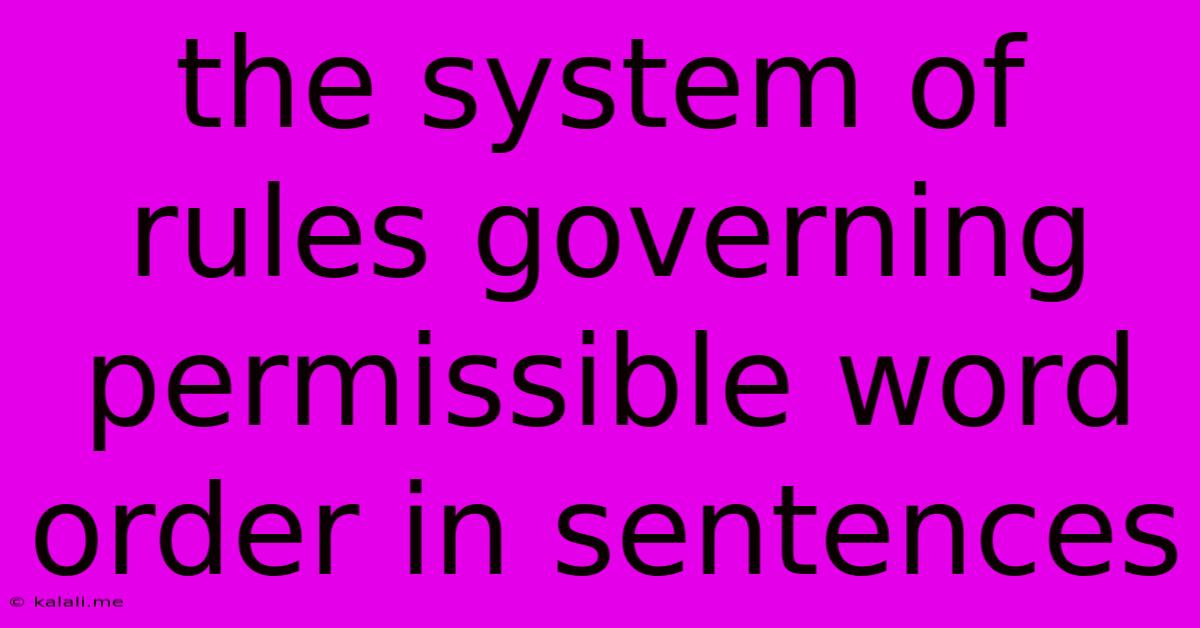The System Of Rules Governing Permissible Word Order In Sentences
Kalali
Jun 14, 2025 · 3 min read

Table of Contents
The System of Rules Governing Permissible Word Order in Sentences: Syntax and Word Classes
Understanding how words combine to form grammatically correct sentences is crucial for effective communication. This involves exploring the system of rules governing permissible word order, a core component of syntax. This article delves into the intricacies of word order, exploring its relationship with word classes, grammatical functions, and the resulting impact on meaning. A grasp of these concepts is vital for writers, linguists, and anyone seeking a deeper understanding of language structure.
What is Syntax?
Syntax, at its core, is the set of principles that govern the structure of sentences. It dictates how words are arranged to create meaningful and grammatically acceptable phrases and clauses. It’s not just about following a prescribed order; syntax dictates the relationships between words, revealing who did what to whom. Think of it as the blueprint of a sentence, outlining the relationships between its building blocks. Different languages employ different syntactic rules, leading to variations in word order.
Word Order and Word Classes
Word classes, or parts of speech (nouns, verbs, adjectives, adverbs, etc.), play a pivotal role in determining permissible word order. Each word class contributes a specific function to the sentence. For instance:
- Nouns: Typically represent entities (people, places, things, ideas).
- Verbs: Express actions or states of being.
- Adjectives: Modify nouns, providing descriptions.
- Adverbs: Modify verbs, adjectives, or other adverbs, adding details of manner, time, or place.
- Prepositions: Show relationships between words (e.g., "on," "in," "to").
The arrangement of these word classes drastically impacts the meaning and grammaticality of a sentence.
Basic Sentence Structure: Subject-Verb-Object (SVO)
Many languages, including English, follow a Subject-Verb-Object (SVO) structure. This means the subject (who performs the action) precedes the verb (the action), which is then followed by the object (what receives the action). For example:
"The cat (Subject) chased (Verb) the mouse (Object)."
Deviating from this basic structure can significantly alter the meaning or create ungrammatical sentences. Consider:
"Mouse the cat chased the." This is ungrammatical.
However, variations within the SVO structure are possible, often influenced by stylistic choices or emphasis:
"The mouse, the cat chased." (Emphasis on the mouse)
Variations in Word Order: Beyond SVO
While SVO is prevalent, many languages employ different basic structures, like Subject-Object-Verb (SOV), Verb-Subject-Object (VSO), or even more complex arrangements. These variations demonstrate the flexibility and diversity inherent in syntactic systems across different languages.
The Role of Context and Ambiguity
Word order is not always definitive. In some cases, the same word order can yield multiple interpretations depending on the context. This ambiguity highlights the importance of considering the broader sentence structure and surrounding information when interpreting meaning.
Transformational Grammar: Moving Parts
Transformational grammar provides a framework for understanding how sentences can be transformed from basic structures to more complex forms through specific rules. These transformations involve moving or adding elements to alter emphasis, create questions, or express different grammatical moods.
Conclusion: Mastering the Rules of Word Order
Understanding the system of rules governing permissible word order is paramount for effective communication and grammatical correctness. By analyzing word classes, basic sentence structures, and the potential for variations and ambiguity, we gain a deeper appreciation for the intricate mechanisms that shape our sentences and ultimately, our language. Continuous study and practice are key to mastering this complex yet fascinating aspect of linguistics.
Latest Posts
Latest Posts
-
An Attitude Of Cultural Relativism Is
Jun 15, 2025
-
Does Kennesaw State Require Sat 2024
Jun 15, 2025
-
Relation Between Youngs Modulus And Shear Modulus
Jun 15, 2025
-
In What Organelle Is Dna Found
Jun 15, 2025
-
Which Of The Following Is Not An Si Unit
Jun 15, 2025
Related Post
Thank you for visiting our website which covers about The System Of Rules Governing Permissible Word Order In Sentences . We hope the information provided has been useful to you. Feel free to contact us if you have any questions or need further assistance. See you next time and don't miss to bookmark.